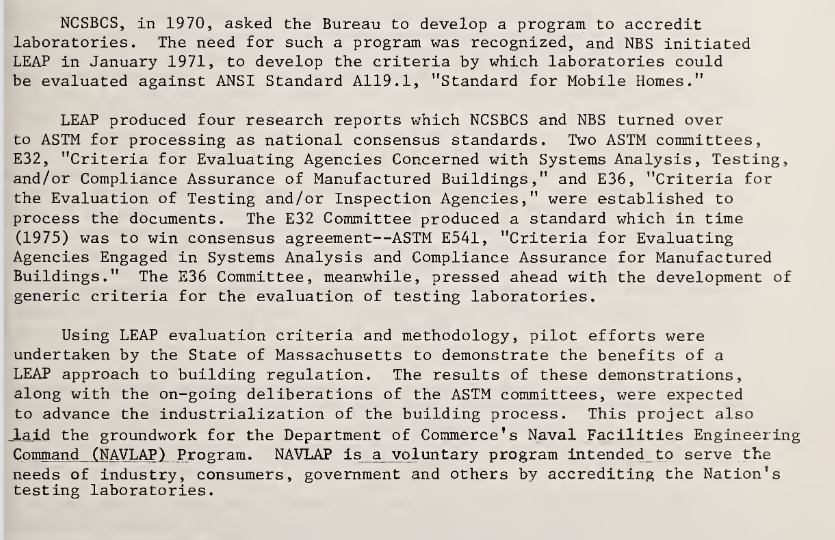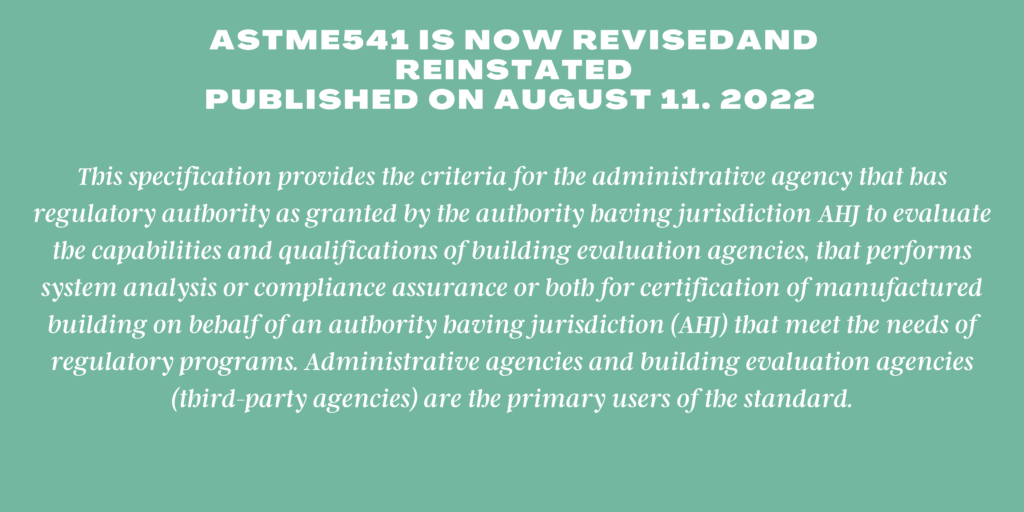ASTME541 Was Revised And Reinstated
Abstract
This specification covers agencies engaged in system analysis and compliance assurance for manufactured building. The administrative agency may utilize the services and facilities of building-evaluation agencies in carrying out its responsibilities for evaluating manufactured building systems. By providing criteria for evaluating these agencies, this standard’s objective is to (1) utilize the voluntary standards system to provide a common base for the various regulatory approaches employed by the authorities having jurisdiction, and (2) make provision for varying degrees of optional technical support for the certification of manufactured building. The system analysis agency is responsible for determining whether a building system, including the design, materials, and fabrication process, is in conformance with applicable requirements. The documents of the system analysis function are: product description document, compliance assurance manual, and installation documents. The general procedures for system analysis are presented in details. The tasks of system analysis project manager, technical staff evaluating building systems, technical staff evaluating compliance assurance manuals, and project manager evaluating building systems are presented in details. The requirements and criteria for compliance assurance agencies are presented. The task of compliance assurance agency project manager, technical staff preparing compliance assurance manuals, compliance assurance supervisor of inspection, and compliance assurance inspector are presented in details.
1. Scope
1.1 This specification provides the criteria for the administrative agency that has regulatory authority as granted by the authority having jurisdiction AHJ to evaluate the capabilities and qualifications of building evaluation agencies, that performs system analysis or compliance assurance or both for certification of manufactured building on behalf of an authority having jurisdiction (AHJ) that meet the needs of regulatory programs. Administrative agencies and building evaluation agencies (third-party agencies) are the primary users of the standard.
1.2 To establish an appropriate degree of intra- and inter-state credibility regarding building system evaluations made through governmental or private agencies, the authorities having jurisdiction should utilize an oversight and approval process for the building-evaluation agencies that provide the services of system analysis or compliance assurance on behalf of the AHJ that may include: approval by the AHJ for both oversight and or auditing of the regulatory body, or approval by the AHJ and oversight, and or auditing by an independent auditor for the regulatory body, or approval with the AHJ and oversight, and auditing by an independent accreditation agency.
Reinstatement of E541-10 Standard Specification for Agencies Engaged in System Analysis and Compliance Assurance for Manufactured Building (Withdrawn 2019)
Rationale
This standard is currently used and referenced in publications including An Index Of US Voluntary Engineering Standards and has been referenced by HUD since the 1970’s. ASTM E541 is currently being referenced in Ca. HDC (California Housing And Community), the Interstate Industrialized Building Commission, the N.H. Code Admin. R. Saf-C 3302.01, and various states including Maine, Illinois, and Virginia. Other countries including Germany, Norway, Britain, Russia, China, and Japan reference ASTM E541. Third-party agencies have long used this standard as a guide to meet the personnel requirements of a AHJ. COTCO recently approved a new committee on tiny house standards that is awaiting the final ASTM International board approval. Proposed tiny house standards will reference sections of this standard. This standard is crucial to contributing to an open marketplace to allow new third party agencies to be established.
For these reasons, this standard is being reinstated. A few changes have been made to clarify concepts or wording. The changes are in the scope, terminology, and section 14.1.2 and are highlighted with revision markup. The main body was not changed since there are administrative rules that quote sections in this standard and the clarification added in the scope and terminology sections provides the clarification that was desired.
This is a concurrent sub/main reinstatement ballot with minor terminology clarification.
Related: Personnel Requirements For 3rd Party Agencies
ASTME541 is a standard that has been used for almost four decades. In simplified terms, it is the personnel requirements for 3rd parties that inspect manufactured structures. The standard was withdrawn in 2019.
Janet Thome Advocated For The Reinstatement Of ASTME541
Janet Thome, the founder and President of Tiny House Aliance USA is leading the exploratory initiative to develop Global Standards For Tiny Houses and has advocated for the reinstatement of ASTME541 in response to the growing concern that ”big box” certification companies were swallowing up smaller 3rd party agencies, and closing the window for new 3rd party agencies to form new companies. They were also adding more and more requirements, which add more costs that ultimately end up adding to the costs to the 3rd parties, the manufacturers and to housing.
This is a great win for small manufacturers and for affordable housing.
The Task Group
Janet Thome Tiny House Alliance USA: Task Group Leader
Bob Gorleski: Vice President Of Manufactured Structures PFS TECO
Randy Saunders: Vice President Of RADCO
James Turner: Engineer And Program Manager IBTS
Robin Butler: NOAH
Ed Nodland: Jet Stream Innovation
Mike Schmidt: Ensemble Ventures
Early History Of ASTME541
The National Conference of States on Building Codes and Standards
(NCSBCS), formed in 1967 to consider problems of building regulation,
has suggested that the states may utilize the services and facilities
of qualified public or private institutions to provide building analyses,
testing and inspections.

Project LEAP: Laboratory Evaluation And Accreditation Program
History Of ASTME541: Criteria For Compliance Assurance Agencies For Manufactured Building April 1973 Prepared By: National Conference Of States On Building Codes And Standards For accreditation purposes.
Project LEAP has divided the building-
evaluation services, that may be performed by accredited agencies, into
three distinct functions;
1) analysis
2) testing
3) compliance assurance
National Conference of States on Building Codes and Standards/National Bureau of Standards.
BTI was involved in seminal work in the development of a regulatory system for factory produced housing in the early 1970s. This work, known as the Laboratory Evaluation and Accreditation Program (LEAP) and the Coordinated Evaluation System (CES), was performed under contract to the National Bureau of Standards and finally incorporated into ASTM E 541-75, “Standard Criteria for Agencies Engaged in System Analysis and Compliance Assurance for Manufactured Building.
California HCD John Westfall’s response to revising ASTME541
Janet,
Congratulations, I appreciate your efforts in resurrecting the standard. Manufactured Housing Program at California Department of Housing and Community Development will be interested in the latest evolution/iteration of E541.
Just a note, the standard currently does not differentiate any particular product or type of industrialized building but only general manufacturing oversight. I am not sure it will do our Department(s) service to focus on any particular type of building being manufactured. The guidance should apply to all products manufactured.Good luck to you.
John J. Westfall
District Representative II
Manufactured and Factory-Built Housing Programs
CA Department of Housing & Community Development
9342 Tech Center Drive, Suite 500 | Sacramento, CA 95826-2581
CA HCD Quality Assurance Inspector Application Approval Checklist
For Inspections Of Commercial Modular-Special Purpose Commercial Modular- And Multi-Unit Manufactured Units
The HUD Code: Code Of Federal Regulations
Displaying title 24, up to date as of 10/05/2022. Title 24 was last amended 9/26/2022
(a) Each primary inspection agency shall have qualified personnel capable of carrying out all of the functions for which the primary inspection agency is seeking to be approved or disapproved. Where a State intends to act as the exclusive IPIA in the State, it shall show that it has adequate personnel to so act in all plants in the State.
(b) Each submission shall indicate the total number of personnel employed by the submitting party, the number of personnel available for this program, and the locations of the activities of the personnel to be used in the program.
(c) Each submission shall include the names and qualifications of the administrator and the supervisor who will be directly responsible for the program, and résumés of their experience.
(d) Each submission shall contain the information set out in paragraphs (d)(1) through (d)(9) of this section. Depending upon the functions (DAPIA or IPIA) to be undertaken by a particular primary inspection agency, some of the categories of personnel listed may not be required. In such cases, the submission should indicate which of the categories of information are not required and explain why they are not needed. The submission should identify which personnel will carry out each of the functions the party plans to perform. The qualifications of the personnel to perform one or more of the functions will be judged in accordance with the requirements of ASTM Standard E-541 except that the requirement for registration as a professional engineer or architect may be waived for personnel whose qualifications by experience or education equal those of a registered engineer or architect.
Interstate IBC
The Interstate Compact on Industrialized/Modular Buildings was created to promote uniformity and encourage coordination in state industrialized buildings programs in a manner to assure interstate reciprocity.
An agency of the member states, the Interstate Industrialized Buildings Commission (IIBC) was established in 1992 and is responsible for carrying out the activities of the compact.
Between 2008 and 2017, registered manufacturers in 44 states and five provinces manufactured 58,644 certified modules.
(C) Industrialized Buildings Inspector and
Trainees
(1) The Commission shall certify an applicant
as an Industrialized Buildings Inspector if the
applicant has met the education and experience
requirements of ASTM E-541, Section 14 and has
successfully completed one of the following
series of tests:
ICC Residential Inspector tests including
building, electrical, mechanical, and plumbing,
or;
NCPCCI One & Two Family Dwelling tests
including building, electrical, mechanical and
plumbing, or;
SBCCI One and Two Family Dwelling
Inspector examination, or;
ICBO Combination Dwelling Inspector
examination.

